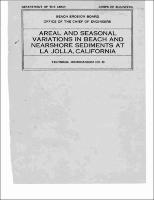Please use this identifier to cite or link to this item:
https://hdl.handle.net/11681/3420Full metadata record
| DC Field | Value | Language |
|---|---|---|
| dc.contributor | United States. Army. Office of the Chief of Engineers | - |
| dc.contributor | Scripps Institution of Oceanography | - |
| dc.contributor.author | Inman, Douglas L. (Douglas Lamar), 1920-2016 | - |
| dc.date.accessioned | 2016-03-16T15:42:33Z | - |
| dc.date.available | 2016-03-16T15:42:33Z | - |
| dc.date.issued | 1953-03 | - |
| dc.identifier.uri | http://hdl.handle.net/11681/3420 | - |
| dc.description | Technical Memorandum | - |
| dc.description | Abstract: The nature of the seasonal distributions of certain physical properties of sediments on the beach and shallow shelf area between two submarine canyon heads was studied at Scripps Institution of Oceanography. The investigation was made from five series of bottom samples obtained periodically from June 1949 to May 1950 along a predetermined grid. Each series consisted of about 130 samples extending from the beach foreshore out to depths of approximately 200 feet. The emphasis in the laboratory analysis of the sediments was on the distribution of particle size. Other properties such as shape, roundness, heavy mineral and carbonate content were also measured. Topographic surveys showing the changes in sand level were made concurrently and on the same grid as the sediment sampling operations. These surveys indicate that beach material migrates seaward during period of large waves and landward during small waves. The most pronounced changes in sand level occur in depths less than 30 feet, but some seasonal effects may extend to greater depths. The greatest change in sediment size also took place from the beach foreshore out to depths of about 30 feet. In this zone the sediments tended to be coarser during the winter and spring when the beaches were cut back, and finer in the fall following the summer fill. The areal distribution of physical properties indicated that the sediments varied in a systematic manner from one locality to another. It was found that the sediments could be divided into types on a basis of particle-size distribution, and that these types were characteristic of the environment of deposition. The beach and intercanyon sediments were grouped into three general environmental types. Type I consists of beach foreshore sands, which were the best sorted sediments in the area. Sends from the surf zone were designed as Type IIa, and were characteristically coarser and more poorly sorted than sediments farther inshore or offshore. These grade into Type IIb which were found on the relatively level portions of the shelf from the surf zone out to depths of approximately 100 feet. Type IIb sediments are predominantly well sorted, very fine sands. Type III sediments are found seaward of Type II b in areas where the bottom slopes more than about 1 in 15. These "slope" sediments usually have more silt, and are characterized by positive skewness and poorer sorting. During times of large waves sediment is lost to the area by transportation into the submarine canyons. Replenishment of this sediment is apparently due to transport around the head of the northern of the two submarine canyons, since the sand along the beach for five miles north of the canyon head is very similar to that in the intercanyon area and the littoral drift here is to the south. A much coarser and better rounded sand is found on the pocket beaches and on the shelf south of the southern canyon head. | - |
| dc.publisher | United States, Beach Erosion Board | - |
| dc.publisher | Engineer Research and Development Center (U.S.) | - |
| dc.relation | http://acwc.sdp.sirsi.net/client/en_US/search/asset/1007560 | - |
| dc.relation.ispartofseries | Technical memorandum (United States. Beach Erosion Board) ; no.39. | - |
| dc.rights | Approved for Public Release, Distribution is Unlimited | - |
| dc.source | This Digital Resource was created from scans of the Print Resource | - |
| dc.subject | Beach Erosion | - |
| dc.subject | Beach Accretion | - |
| dc.subject | Deposition | - |
| dc.subject | La Jolla, California | - |
| dc.subject | Particle Size Analysis | - |
| dc.subject | Sand | - |
| dc.subject | Sediments | - |
| dc.subject | Nearshore Sediments | - |
| dc.title | Areal and seasonal variations in beach and nearshore sediments at La Jolla, California | - |
| dc.type | Report | en_US |
| Appears in Collections: | Technical Memorandum | |
Files in This Item:
| File | Description | Size | Format | |
|---|---|---|---|---|
| BEB-TM-39.pdf | 27.7 MB | Adobe PDF |  View/Open |